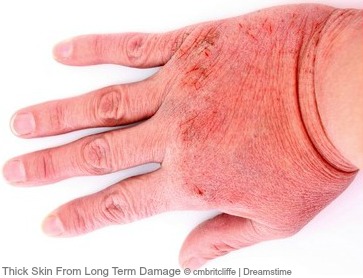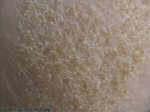Thick Skin Is A Long Term Eczema Symptom That Loves Lots Of Emollient
Thick skin starts appearing when your skin is scratched and rubbed over a period of time.
It happens because the skin protects itself to prevent further damage.

It does this by producing a protein found in the skin cells, called Keratin.
This process is called Keratinization. It causes the skin to look leathery and thickened.
Characteristics Of Thick Skin
Thickened skin can look more lined and aged. My hands sometimes look at least ten years older than I am!
It is also less flexible. Eczema is often found where the body bends e.g. at the elbows and the knees.
This can make it sore and painful when using and bending them. It can also cause the skin to break and split easier.
My knuckles and the sides of my hands split easy when I have an outbreak. I end up with dry cracked skin. As you probably can imagine, and probably even know, it can be pretty painful.
It is difficult not to bend or use some parts of your body. Especially even when doing everyday tasks.
This is why it is important to keep the skin moisturised, and to avoid irritants and allergens as much as possible. Prevention is definitely easier and better in the long run for your skin, than treating.
Self Management
Moisturising helps protect the skin from further drying and breaking.
When
the surface breaks it is more likely to allow irritants and bacteria to
enter into the deeper layers of the skin. These cause damage to the
skin. The itch-scratch cycle continues, and your eczema may worsen.
The look of the thickened skin is unlikely to improve over time. The best thing you can do is to keep the skin moisturised and not to scratch it. This will stop any further damage being done.
When the skin is broken it is advised not to apply topical steroids to the area. This is especially true of creams which are a high strength steroid.
I keep the affected areas clean and I find applying a dressing helps. It stops bacteria and irritants getting in and can help with preventing scratching. Both of these preventive measures help with reducing the chance of a bacterial infection.
Return from Thick Skin to Eczema Symptoms
Return from Thick Skin to What is Eczema
Search What Is Eczema?
Advertising on What Is Eczema?
We are a participant in the Amazon Services LLC Associates Program, an affiliate program which allows sites to earn fees by advertising and linking to amazon.com. If you make a purchase through a link on this page, I may receive a small commission, at no extra cost to you. Many thanks
